![Anti-alpha 3 Sodium Potassium ATPase antibody [XVIF9-G10] (ab2826) at 1/1000 dilution (5% Milk for 1 hour 30 minutes at 24°C.) + Human brain cortex whole tissue lysate (10µg). with 5% Milk for 1 hour for 24°C.SecondaryAn HRP-conjugated goat anti-mouse IgG1 at 1/5000 dilutionThis image is courtesy of an anonymous AbreviewSee Abreview](http://www.bioprodhub.com/system/product_images/ab_products/2/sub_1/5508_alpha-3-Sodium-Potassium-ATPase-Primary-antibodies-ab2826-2.jpg)
Anti-alpha 3 Sodium Potassium ATPase antibody [XVIF9-G10] (ab2826) at 1/1000 dilution (5% Milk for 1 hour 30 minutes at 24°C.) + Human brain cortex whole tissue lysate (10µg). with 5% Milk for 1 hour for 24°C.SecondaryAn HRP-conjugated goat anti-mouse IgG1 at 1/5000 dilutionThis image is courtesy of an anonymous AbreviewSee Abreview
![Overlay histogram showing SH-SY5Y cells stained with ab2826 (red line). The cells were fixed with 4% paraformaldehyde and incubated in 1x PBS / 10% normal goat serum / 0.3M glycine to block non-specific protein-protein interactions. The cells were then incubated with the antibody (ab2826, 1µg/1x106 cells) for 30 min at 22ºC. The secondary antibody used was DyLight® 488 goat anti-mouse IgG (H+L) (ab96879) at 1/500 dilution for 30 min at 22ºC. Isotype control antibody (black line) was mouse IgG1 [ICIGG1] (ab91353, 2µg/1x106 cells) used under the same conditions. Acquisition of >5,000 events was performed.Please note that Abcam do not have any data for use of this antibody on non-fixed cells. We welcome any customer feedback.](http://www.bioprodhub.com/system/product_images/ab_products/2/sub_1/5509_alpha-3-Sodium-Potassium-ATPase-Primary-antibodies-ab2826-4.jpg)
Overlay histogram showing SH-SY5Y cells stained with ab2826 (red line). The cells were fixed with 4% paraformaldehyde and incubated in 1x PBS / 10% normal goat serum / 0.3M glycine to block non-specific protein-protein interactions. The cells were then incubated with the antibody (ab2826, 1µg/1x106 cells) for 30 min at 22ºC. The secondary antibody used was DyLight® 488 goat anti-mouse IgG (H+L) (ab96879) at 1/500 dilution for 30 min at 22ºC. Isotype control antibody (black line) was mouse IgG1 [ICIGG1] (ab91353, 2µg/1x106 cells) used under the same conditions. Acquisition of >5,000 events was performed.Please note that Abcam do not have any data for use of this antibody on non-fixed cells. We welcome any customer feedback.
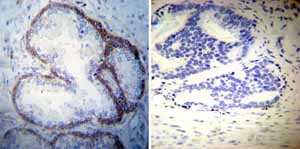
Immunohistochemistry was performed on both normal and cancer biopsies of deparaffinized Human prostate carcinoma tissues. To expose target proteins heat induced antigen retrieval was performed using 10mM sodium citrate (pH6.0) buffer microwaved for 8-15 minutes. Following antigen retrieval tissues were blocked in 3% BSA-PBS for 30 minutes at room temperature. Tissues were then probed at a dilution of 1:50 with a mouse monoclonal antibody recognizing Sodium/Potassium ATPase alpha-3 ab2826 or without primary antibody (negative control) overnight at 4°C in a humidified chamber. Tissues were washed extensively with PBST and endogenous peroxidase activity was quenched with a peroxidase suppressor. Detection was performed using a biotin-conjugated secondary antibody and SA-HRP followed by colorimetric detection using DAB. Tissues were counterstained with hematoxylin and prepped for mounting.
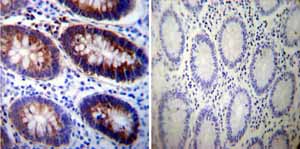
Immunohistochemistry was performed on both normal and cancer biopsies of deparaffinized Human colon tissue tissues. To expose target proteins heat induced antigen retrieval was performed using 10mM sodium citrate (pH6.0) buffer microwaved for 8-15 minutes. Following antigen retrieval tissues were blocked in 3% BSA-PBS for 30 minutes at room temperature. Tissues were then probed at a dilution of 1:200 with a mouse monoclonal antibody recognizing Sodium/Potassium ATPase alpha-3 ab2826 or without primary antibody (negative control) overnight at 4°C in a humidified chamber. Tissues were washed extensively with PBST and endogenous peroxidase activity was quenched with a peroxidase suppressor. Detection was performed using a biotin-conjugated secondary antibody and SA-HRP followed by colorimetric detection using DAB. Tissues were counterstained with hematoxylin and prepped for mounting.
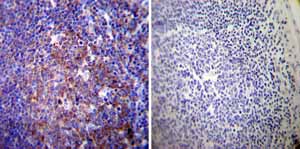
Immunohistochemistry was performed on both normal and cancer biopsies of deparaffinized Human tonsil tissue tissues. To expose target proteins heat induced antigen retrieval was performed using 10mM sodium citrate (pH6.0) buffer microwaved for 8-15 minutes. Following antigen retrieval tissues were blocked in 3% BSA-PBS for 30 minutes at room temperature. Tissues were then probed at a dilution of 1:200 with a mouse monoclonal antibody recognizing Sodium/Potassium ATPase alpha-3 ab2826 or without primary antibody (negative control) overnight at 4°C in a humidified chamber. Tissues were washed extensively with PBST and endogenous peroxidase activity was quenched with a peroxidase suppressor. Detection was performed using a biotin-conjugated secondary antibody and SA-HRP followed by colorimetric detection using DAB. Tissues were counterstained with hematoxylin and prepped for mounting.
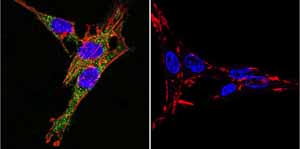
Immunofluorescent analysis of Sodium/Potassium ATPase alpha-3 using Sodium/Potassium ATPase alpha-3 Monoclonal antibody (XVIF9-G10) ab2826 shows staining in C6 glioma cells. Sodium/Potassium ATPase alpha-3 staining (green) F-Actin staining with Phalloidin (red) and nuclei with DAPI (blue) is shown. Cells were grown on chamber slides and fixed with formaldehyde prior to staining. Cells were probed without (control) or with or an antibody recognizing Sodium/Potassium ATPase alpha-3 ab2826 at a dilution of 1:20 over night at 4 ?C washed with PBS and incubated with a DyLight-488 conjugated secondary antibody. Images were taken at 60X magnification.
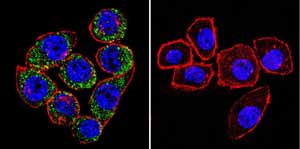
Immunofluorescent analysis of Sodium/Potassium ATPase alpha-3 using Sodium/Potassium ATPase alpha-3 Monoclonal antibody (XVIF9-G10) ab2826 shows staining in U251 glioma cells. Sodium/Potassium ATPase alpha-3 staining (green) F-Actin staining with Phalloidin (red) and nuclei with DAPI (blue) is shown. Cells were grown on chamber slides and fixed with formaldehyde prior to staining. Cells were probed without (control) or with or an antibody recognizing Sodium/Potassium ATPase alpha-3 ab2826 at a dilution of 1:20 over night at 4 ?C washed with PBS and incubated with a DyLight-488 conjugated secondary antibody. Images were taken at 60X magnification.
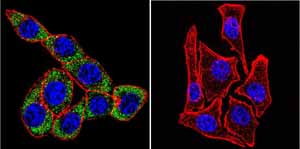
Immunofluorescent analysis of Sodium/Potassium ATPase alpha-3 using Sodium/Potassium ATPase alpha-3 Monoclonal antibody (XVIF9-G10) ab2826 shows staining in HeLa cells. Sodium/Potassium ATPase alpha-3 staining (green) F-Actin staining with Phalloidin (red) and nuclei with DAPI (blue) is shown. Cells were grown on chamber slides and fixed with formaldehyde prior to staining. Cells were probed without (control) or with or an antibody recognizing Sodium/Potassium ATPase alpha-3 ab2826 at a dilution of 1:20 over night at 4 ?C washed with PBS and incubated with a DyLight-488 conjugated secondary antibody. Images were taken at 60X magnification.
![Anti-alpha 3 Sodium Potassium ATPase antibody [XVIF9-G10] (ab2826) at 1/1000 dilution (5% Milk for 1 hour 30 minutes at 24°C.) + Human brain cortex whole tissue lysate (10µg). with 5% Milk for 1 hour for 24°C.SecondaryAn HRP-conjugated goat anti-mouse IgG1 at 1/5000 dilutionThis image is courtesy of an anonymous AbreviewSee Abreview](http://www.bioprodhub.com/system/product_images/ab_products/2/sub_1/5508_alpha-3-Sodium-Potassium-ATPase-Primary-antibodies-ab2826-2.jpg)
![Overlay histogram showing SH-SY5Y cells stained with ab2826 (red line). The cells were fixed with 4% paraformaldehyde and incubated in 1x PBS / 10% normal goat serum / 0.3M glycine to block non-specific protein-protein interactions. The cells were then incubated with the antibody (ab2826, 1µg/1x106 cells) for 30 min at 22ºC. The secondary antibody used was DyLight® 488 goat anti-mouse IgG (H+L) (ab96879) at 1/500 dilution for 30 min at 22ºC. Isotype control antibody (black line) was mouse IgG1 [ICIGG1] (ab91353, 2µg/1x106 cells) used under the same conditions. Acquisition of >5,000 events was performed.Please note that Abcam do not have any data for use of this antibody on non-fixed cells. We welcome any customer feedback.](http://www.bioprodhub.com/system/product_images/ab_products/2/sub_1/5509_alpha-3-Sodium-Potassium-ATPase-Primary-antibodies-ab2826-4.jpg)





